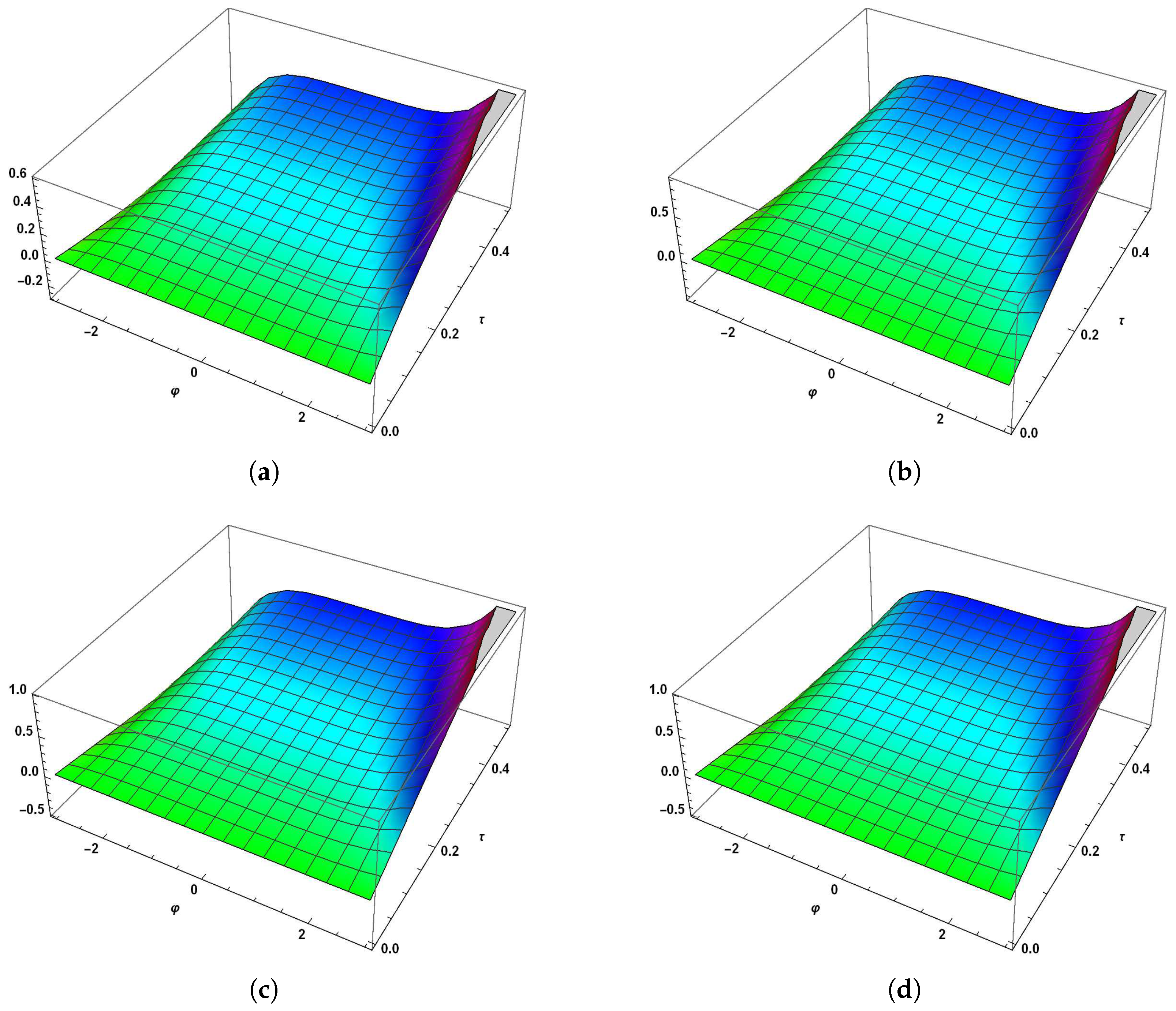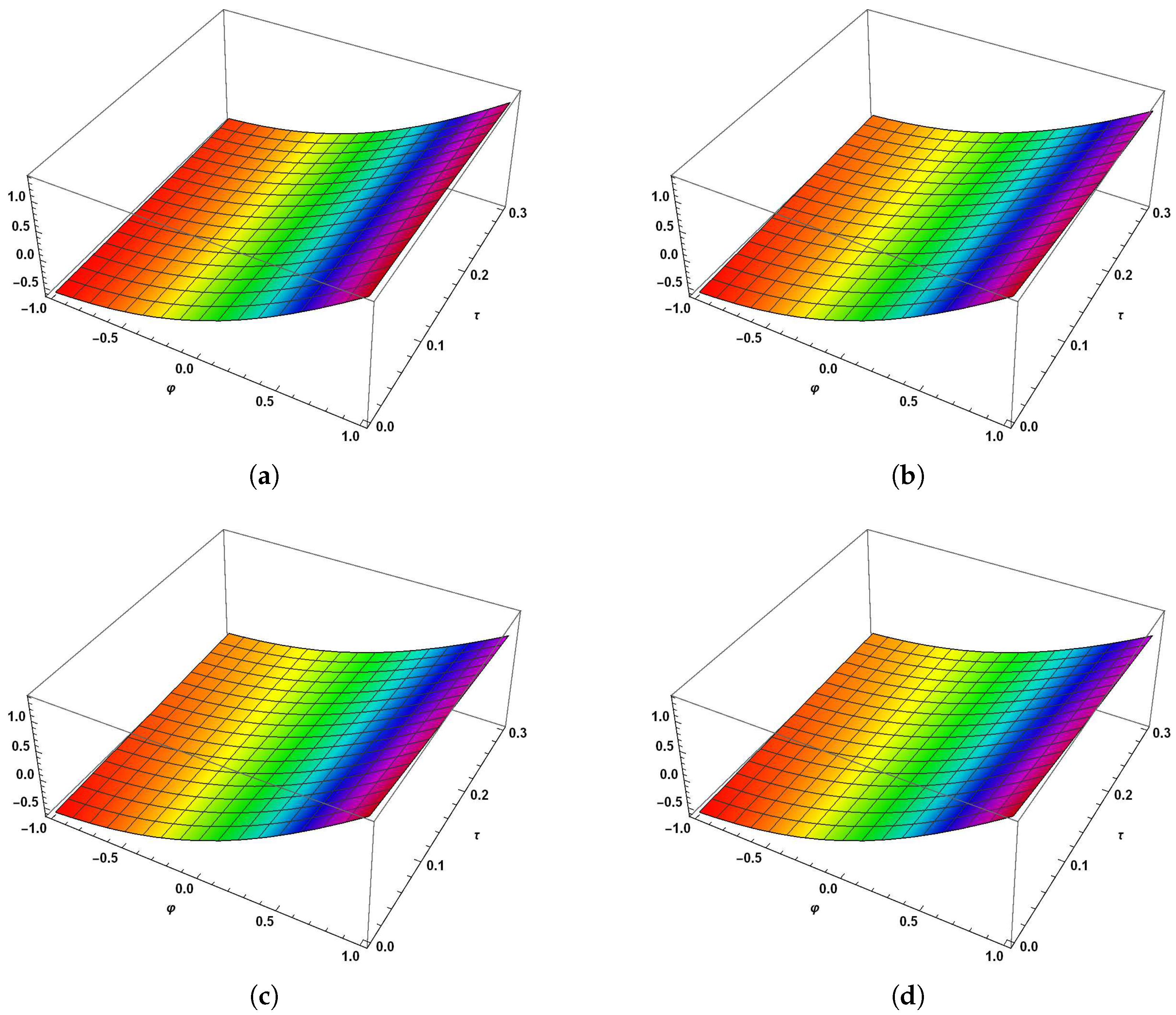Approximate Solution to Fractional Order Models Using a New Fractional Analytical Scheme
Abstract
:1. Introduction
2. Concepts of Fractional Calculus
3. Development of New Fractional Analytical Scheme (NFAS)
4. Convergence and Stability Analysis of NFAS
4.1. Convergence Analysis
4.2. Stability Analysis
5. Numerical Applications
5.1. Example 1
5.2. Example 2
5.3. Example 3
6. Conclusions and Future Work
Author Contributions
Funding
Institutional Review Board Statement
Informed Consent Statement
Data Availability Statement
Conflicts of Interest
References
- Wang, K.J.; Li, G.; Liu, J.H.; Wang, G.D. Solitary waves of the fractal regularized long-wave equation traveling along an unsmooth boundary. Fractals 2022, 30, 2250008. [Google Scholar] [CrossRef]
- Peng, Z.; Hu, J.; Shi, K.; Luo, R.; Huang, R.; Ghosh, B.K.; Huang, J. A novel optimal bipartite consensus control scheme for unknown multi-agent systems via model-free reinforcement learning. Appl. Math. Comput. 2020, 369, 124821. [Google Scholar] [CrossRef]
- Li, X.; Dong, Z.Q.; Wang, L.P.; Niu, X.D.; Yamaguchi, H.; Li, D.C.; Yu, P. A magnetic field coupling fractional step lattice Boltzmann model for the complex interfacial behavior in magnetic multiphase flows. Appl. Math. Model. 2023, 117, 219–250. [Google Scholar] [CrossRef]
- Jin, H.Y.; Wang, Z.A. Global stabilization of the full attraction-repulsion Keller-Segel system. Discret. Contin. Dyn.-Syst. Ser. A 2019, 40, 3509–3527. [Google Scholar] [CrossRef] [Green Version]
- Gorenflo, R.; Mainardi, F. Fractional Calculus: Integral and Differential Equations of Fractional Order; Springer: Berlin/Heidelberg, Germany, 1997. [Google Scholar]
- Kumar, S.; Kumar, A.; Samet, B.; Dutta, H. A study on fractional host–parasitoid population dynamical model to describe insect species. Numer. Methods Partial. Differ. Equ. 2021, 37, 1673–1692. [Google Scholar] [CrossRef]
- Wang, T.; Wang, G.; Yang, X.J. On a Hadamard-type fractional turbulent flow model with deviating arguments in a porous medium. Nonlinear Anal. Model. Control 2017, 22, 765–784. [Google Scholar] [CrossRef]
- Qureshi, S.; Atangana, A. Fractal-fractional differentiation for the modeling and mathematical analysis of nonlinear diarrhea transmission dynamics under the use of real data. Chaos Solitons Fractals 2020, 136, 109812. [Google Scholar] [CrossRef]
- Lyu, W.; Wang, Z.A. Global classical solutions for a class of reaction-diffusion system with density-suppressed motility. Electron. Res. Arch. 2021, 30, 995–1015. [Google Scholar] [CrossRef]
- Qureshi, S.; Kumar, P. Using Shehu integral transform to solve fractional order Caputo type initial value problems. J. Appl. Math. Comput. Mech. 2019, 18, 75–83. [Google Scholar] [CrossRef]
- AL-Jawary, M. Analytic solutions for solving fourth-order parabolic partial differential equations with variable coefficients. Int. J. Adv. Sci. Technol. Res. 2015, 3, 531–545. [Google Scholar]
- Nadeem, M.; Li, F.; Ahmad, H. Modified Laplace variational iteration method for solving fourth-order parabolic partial differential equation with variable coefficients. Comput. Math. Appl. 2019, 78, 2052–2062. [Google Scholar] [CrossRef]
- Li, J.; Chen, Y.; Liu, G. High-order compact ADI methods for parabolic equations. Comput. Math. Appl. 2006, 52, 1343–1356. [Google Scholar] [CrossRef] [Green Version]
- Nadeem, M.; Li, Z. A new strategy for the approximate solution of fourth-order parabolic partial differential equations with fractional derivative. Int. J. Numer. Methods Heat Fluid Flow 2022, 33, 1062–1075. [Google Scholar] [CrossRef]
- Kheyrinataj, F.; Nazemi, A. Fractional power series neural network for solving delay fractional optimal control problems. Connect. Sci. 2020, 32, 53–80. [Google Scholar] [CrossRef]
- Mamehrashi, K. Ritz approximate method for solving delay fractional optimal control problems. J. Comput. Appl. Math. 2023, 417, 114606. [Google Scholar] [CrossRef]
- Arikoglu, A.; Ozkol, I. Solution of fractional differential equations by using differential transform method. Chaos Solitons Fractals 2007, 34, 1473–1481. [Google Scholar] [CrossRef]
- Liu, L.; Wang, J.; Zhang, L.; Zhang, S. Multi-AUV dynamic maneuver countermeasure algorithm based on interval information game and fractional-order DE. Fractal Fract. 2022, 6, 235. [Google Scholar] [CrossRef]
- Li, Y.; Zhao, W. Haar wavelet operational matrix of fractional order integration and its applications in solving the fractional order differential equations. Appl. Math. Comput. 2010, 216, 2276–2285. [Google Scholar] [CrossRef]
- Wang, K.L.; Wang, K.J. A modification of the reduced differential transform method for fractional calculus. Therm. Sci. 2018, 22, 1871–1875. [Google Scholar] [CrossRef] [Green Version]
- Luo, R.; Peng, Z.; Hu, J. On model identification based optimal control and it’s applications to multi-agent learning and control. Mathematics 2023, 11, 906. [Google Scholar] [CrossRef]
- Pandir, Y.; Ekin, A. New solitary wave solutions of the Korteweg-de Vries (KdV) equation by new version of the trial equation method. Electron. J. Appl. Math. 2023, 1, 101–113. [Google Scholar]
- Zurigat, M.; Momani, S.; Odibat, Z.; Alawneh, A. The homotopy analysis method for handling systems of fractional differential equations. Appl. Math. Model. 2010, 34, 24–35. [Google Scholar] [CrossRef]
- Zhang, J.; Xie, J.; Shi, W.; Huo, Y.; Ren, Z.; He, D. Resonance and bifurcation of fractional quintic Mathieu–Duffing system. Chaos Interdiscip. J. Nonlinear Sci. 2023, 33, 23131. [Google Scholar] [CrossRef] [PubMed]
- Kexue, L.; Jigen, P. Laplace transform and fractional differential equations. Appl. Math. Lett. 2011, 24, 2019–2023. [Google Scholar] [CrossRef] [Green Version]
- Wang, K.J.; Wang, G.D. He’s variational method for the time–space fractional nonlinear Drinfeld–Sokolov–Wilson system. Math. Methods Appl. Sci. 2023, 46, 7798–7806. [Google Scholar] [CrossRef]
- Nejla, G.; Emine, G.K.; Yusuf, G. Chebyshev-Tau method for the linear Klein-Gordon equation. Int. J. Phys. Sci. 2012, 7, 5723–5728. [Google Scholar]
- Sarikaya, M.Z.; Ogunmez, H. On new inequalities via Riemann-Liouville fractional integration. Abstr. Appl. Anal. 2012, 2012, 428983. [Google Scholar] [CrossRef]
- Farid, G. Some Riemann–Liouville fractional integral inequalities for convex functions. J. Anal. 2019, 27, 1095–1102. [Google Scholar] [CrossRef]
- Liu, Q.; Peng, H.; Wang, Z.A. Convergence to nonlinear diffusion waves for a hyperbolic-parabolic chemotaxis system modelling vasculogenesis. J. Differ. Equ. 2022, 314, 251–286. [Google Scholar] [CrossRef]
- Ali, K.K.; Maneea, M. New approximation solution for time-fractional Kudryashov-Sinelshchikov equation using novel technique. Alex. Eng. J. 2023, 72, 559–572. [Google Scholar] [CrossRef]
- Sene, N. Exponential form for Lyapunov function and stability analysis of the fractional differential equations. J. Math. Comput. Sci. 2018, 18, 388–397. [Google Scholar] [CrossRef] [Green Version]
- Khan, A.; Syam, M.I.; Zada, A.; Khan, H. Stability analysis of nonlinear fractional differential equations with Caputo and Riemann-Liouville derivatives. Eur. Phys. J. Plus 2018, 133, 264. [Google Scholar] [CrossRef]
- Hattaf, K. On the stability and numerical scheme of fractional differential equations with application to biology. Computation 2022, 10, 97. [Google Scholar] [CrossRef]



| Exact Solution | ||||
|---|---|---|---|---|
| 0.10 | 0.190039 | 0.274522 | 0.29552 | 0.29552 |
| 0.15 | 0.190039 | 0.274522 | 0.29552 | 0.29552 |
| 0.20 | 0.190039 | 0.274523 | 0.29551 | 0.29551 |
| 0.25 | 0.190040 | 0.274524 | 0.295523 | 0.295523 |
| 0.30 | 0.190042 | 0.274528 | 0.295526 | 0.295526 |
| 0.35 | 0.190047 | 0.274534 | 0.295533 | 0.295533 |
| 0.40 | 0.190055 | 0.274545 | 0.295545 | 0.295545 |
| 0.45 | 0.0190068 | 0.274564 | 0.295566 | 0.295566 |
| 0.50 | 0.190088 | 0.274594 | 0.295597 | 0.295597 |
| Exact Solution | ||||
|---|---|---|---|---|
| 0.10 | 0.380073 | 0.549038 | 0.591034 | 0.591034 |
| 0.15 | 0.380073 | 0.549038 | 0.591034 | 0.591034 |
| 0.20 | 0.380073 | 0.549038 | 0.591034 | 0.591034 |
| 0.25 | 0.380073 | 0.549038 | 0.591034 | 0.591034 |
| 0.30 | 0.380073 | 0.549038 | 0.591034 | 0.591034 |
| 0.35 | 0.380073 | 0.549039 | 0.591035 | 0.591035 |
| 0.40 | 0.380074 | 0.549040 | 0.591036 | 0.591036 |
| 0.45 | 0.380075 | 0.549041 | 0.591037 | 0.591037 |
| 0.50 | 0.380077 | 0.549044 | 0.591040 | 0.591040 |
| Exact Solution | ||||
|---|---|---|---|---|
| 0.10 | −1.56817 | −1.47581 | −1.42272 | −1.42272 |
| 0.15 | −1.51193 | −1.41958 | −1.36648 | −1.36648 |
| 0.20 | −1.45323 | −1.36087 | −1.30778 | −1.30778 |
| 0.25 | −1.39208 | −1.29972 | −1.24662 | −1.24662 |
| 0.30 | −1.3285 | −1.23614 | −1.18305 | −1.18305 |
| 0.35 | −1.26254 | −1.17018 | −1.11708 | −1.11708 |
| 0.40 | −1.19422 | −1.10187 | −1.04877 | −1.04877 |
| 0.45 | −1.12361 | −1.03125 | −0.978158 | −0.978158 |
| 0.50 | −1.05075 | −0.958389 | −0.905293 | −0.905293 |
Disclaimer/Publisher’s Note: The statements, opinions and data contained in all publications are solely those of the individual author(s) and contributor(s) and not of MDPI and/or the editor(s). MDPI and/or the editor(s) disclaim responsibility for any injury to people or property resulting from any ideas, methods, instructions or products referred to in the content. |
© 2023 by the authors. Licensee MDPI, Basel, Switzerland. This article is an open access article distributed under the terms and conditions of the Creative Commons Attribution (CC BY) license (https://creativecommons.org/licenses/by/4.0/).
Share and Cite
Nadeem, M.; Iambor, L.F. Approximate Solution to Fractional Order Models Using a New Fractional Analytical Scheme. Fractal Fract. 2023, 7, 530. https://doi.org/10.3390/fractalfract7070530
Nadeem M, Iambor LF. Approximate Solution to Fractional Order Models Using a New Fractional Analytical Scheme. Fractal and Fractional. 2023; 7(7):530. https://doi.org/10.3390/fractalfract7070530
Chicago/Turabian StyleNadeem, Muhammad, and Loredana Florentina Iambor. 2023. "Approximate Solution to Fractional Order Models Using a New Fractional Analytical Scheme" Fractal and Fractional 7, no. 7: 530. https://doi.org/10.3390/fractalfract7070530






